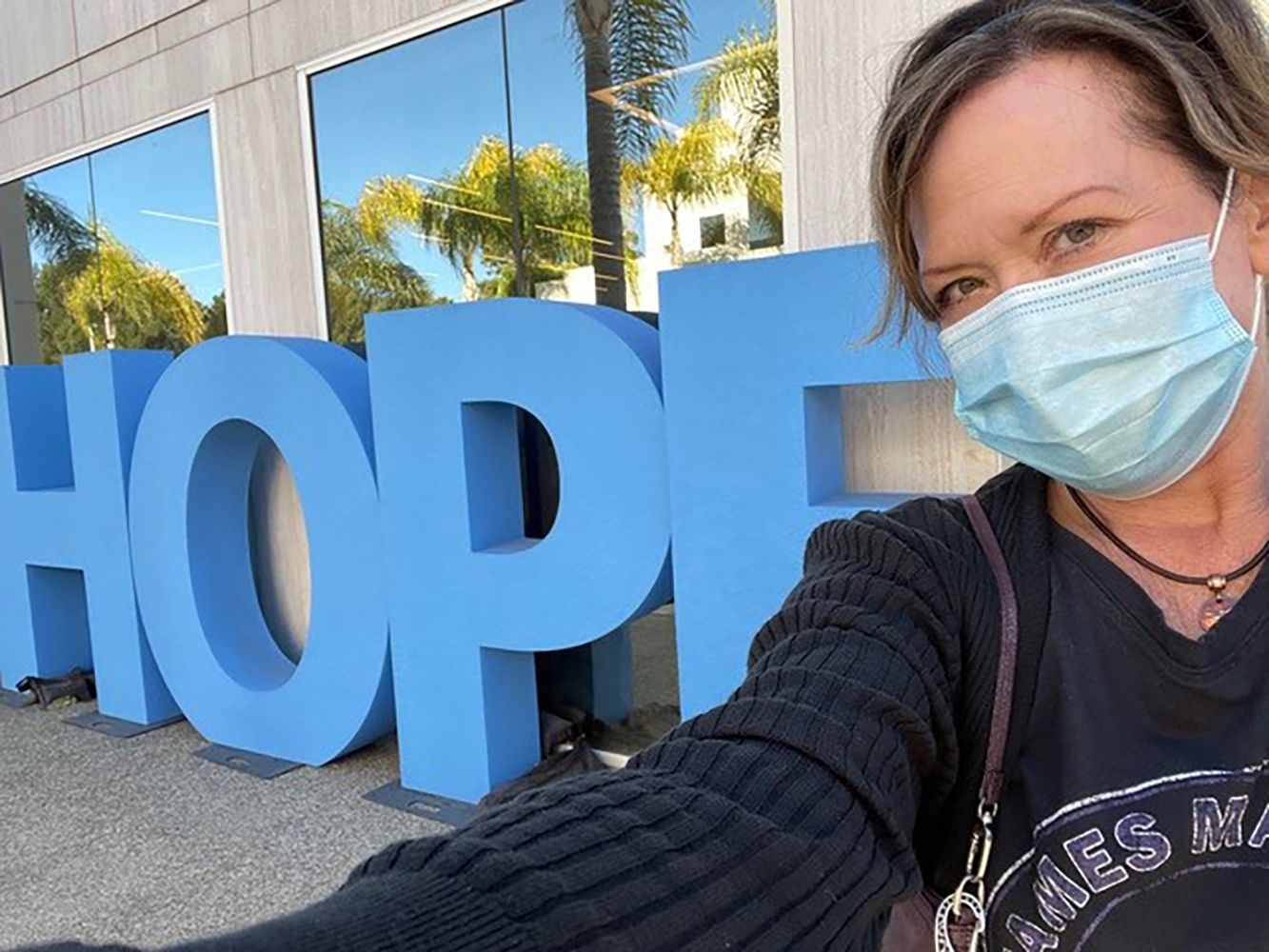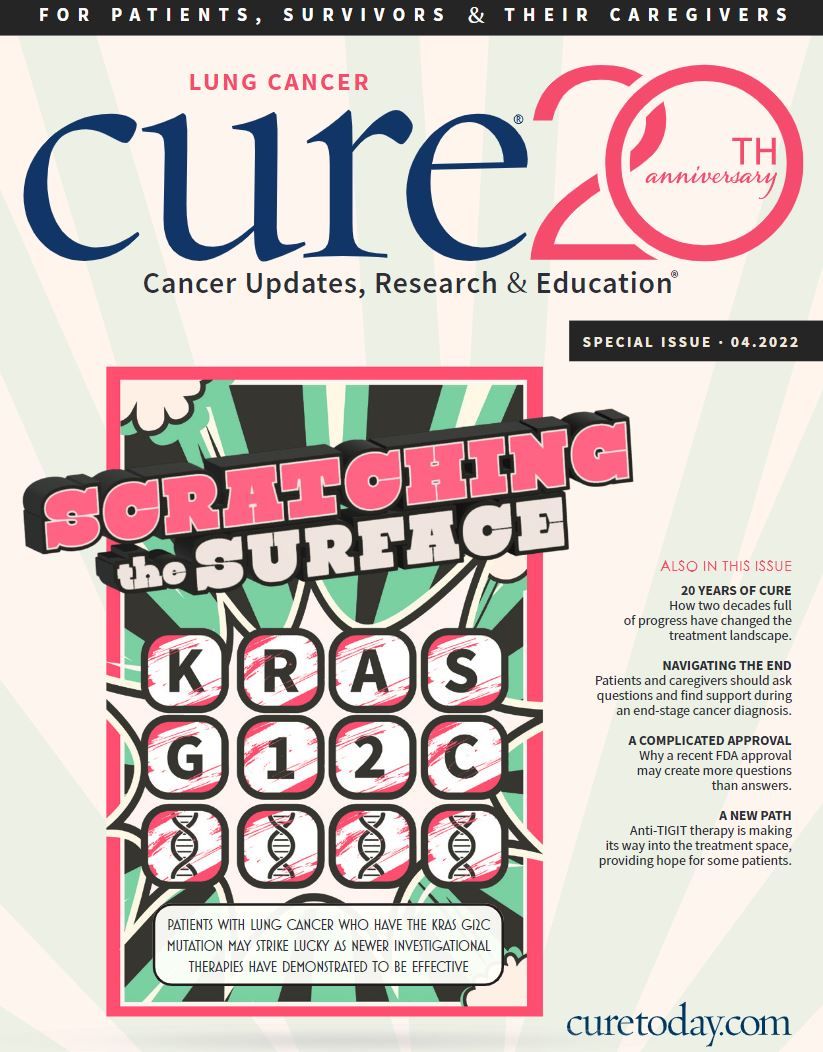Targeted Therapy Advances in Lung Cancer Space Over Past 2 Decades 'Simply Remarkable'
Over the past 20 years, advancements in the lung cancer space have led to a drastic paradigm shift in how patients are now treated, ultimately leading to substantial improvements in survival and patient quality of life.
Peg Berens of Newport Beach, California, was 54 when she developed a mild wheeze in January 2020.
At first, she brushed it off as she had a history of asthma. However, within a month, her condition worsened. After undergoing a chest X-ray at a nearby clinic, Berens was diagnosed with pneumonia.
The treatments prescribed for the infection didn’t work, and she kept getting sicker. She was hospitalized and was sent to receive a chest scan. Her lungs were inflamed, and her pulmonologist saw a spot on her liver. She was released and told to get her liver biopsied.
On April 1, 2020, Berens received the shocking news that she had stage 4b non-small cell adenocarcinoma of the lung. The cancer had also spread to her entire spine, pelvis, lymph nodes and liver.
Peg Berens takes a selfie outside of City of Hope Orange County the day she received a blood draw to participate in a clinical trial to assess if there are any additional genomic mutatations driving her new progression.

“It’s shocking to think that a few months before I was fine, and the next thing you know, get a terminal diagnosis,” she says.
Berens, a never smoker, was referred by her physician, Dr. Nishan Tchekmedyian, regional medical director for City of Hope Orange County in California, to undergo biomarker testing.
She recalls he said, “This is of extreme importance. Because if you have this ALK gene (mutation), there’s targeted therapies for it and that’s going to make a huge difference.”
Biomarker testing, according to the National Cancer Institute, offers insight into the possible presence of genes, proteins and biomarkers or tumor markers that can provide information about a person’s cancer. This type of testing is imperative because certain cancer treatments, such as targeted therapies, work best in patients whose disease is shown to have a mutation.
Because she was declining so rapidly, Berens received chemotherapy while she waited for the results of her genetic test to return. Ten days later, the results showed that she was ALK-positive.
“This was a very positive thing to happen in this really terrible situation, because it meant that there were targeted therapies available, and that meant hope,” she says.
During this time, Berens was on oxygen and could barely take a few steps before having to catch her breath. She and her husband began getting their affairs in order as they thought she wouldn’t live past three months. That is, she notes, until she was prescribed Alecensa (alectinib).
“(It was) like going from my deathbed, practically, to off of oxygen,” Berens says. “And then within a couple of weeks, I’m able to walk around again, and within a month, I’m going on walks in our neighborhood. It was really a miracle.”
Along with Berens, countless patients, including Gina Hollenbeck of Collierville, Tennessee, have derived some benefit from biomarker-driven therapies.
At 38 years old, Hollenbeck, a former nurse, was diagnosed with stage 4 lung cancer that had already metastasized to her brain in 2015. Her doctor recommended that she immediately receive genomic testing.
A genomic test determined that Gina Hollenbeck had ALK-positive lung cancer.

“He’s like, ‘Gina, I want to send away for this test. It might determine that you are actually eligible for a little pill instead of doing IV chemo,’” she recalls.
The test determined that she had ALK-positive disease. She first started on Zykadia (ceritinib), but her insurance would not cover the $16,000-a-month cost since it was only Food and Drug Administration (FDA)-approved for patients whose disease progressed on or was intolerant to first-line Xalkori (crizotinib). She notes that she was only able to start Zykadia because friends and family raised $30,000 via a GoFundMe page. For the first two months, she started with second-line treatment and in that time her disease disappeared.
But she had to switch to Xalkori once she could no longer afford the second-line treatment. Within four weeks, Hollenbeck says, she developed five brain metastases. Since she fit the criteria for Zykadia, her insurance now covered it. After she started back on Zykadia, there was no evidence of disease.
A Different Time
Personalized cancer treatments that are tailored to an individual’s disease based on the results of a biomarker test weren’t always the norm.
Twenty years ago, there was tremendous pessimism when a person was diagnosed with lung cancer, recalls Dr. Edward S. Kim, physician-in-chief and senior vice president at City of Hope Orange County.
“They were going to get cytotoxic chemotherapy and it would not work that well,” he says. “From a clinician standpoint, it was managing which drug and treatment schedule a patient would probably most tolerate without harming them.”
Findings from the ECOG 1594 trial, published in The New England Journal of Medicine in 2002, further validated this notion when the data showed that, out of four different platinum-based doublet chemotherapies, there was no difference in survival.
“Pretty much the conclusion was for clinicians to define the one (regimen) they perceive has the most tolerable side effect profile and use that,” Kim says.
The standard of care, he says, was to use two chemotherapies as a front-line treatment option, and then one chemotherapy in the second line if a patient’s disease worsened.
“That was pretty much it,” he remembers.
But over the next decade, developments in the lung cancer space would make way for an era that would ultimately change the lives of thousands of patients.
Biologics Before Biomarkers
The earliest lung cancer biologic introduced to the public, according to Kim, was Iressa (gefitinib).
At the time, study results were showing that treatment with Iressa — a once-daily oral therapy — induced response rates and survival rates similar to what had been seen previously with chemotherapies.
But this development was made outside of the biomarker space, meaning researchers were just testing the safety and efficacy of a biologic medication compared with infusion-delivered chemotherapy in patients with lung cancer.
There were also other biologics being testing in this patient population, many of which would receive FDA approval. However, as Kim points out, none of these developments occurred in connection with the presence of biomarkers.
As he recalls, the time from 2000 to 2012 was a transitional period in the lung cancer space.
“(The space went) from second-line chemotherapy finally being validated, and that was against best supportive care, so not a great way to prove something is that much better, to biologic agents, to the story of (Iressa) which was fast tracked, approved and then pulled off the market because its large phase 4 study didn’t meet its survival end point,” Kim adds encapsulating the developments.
Then, in 2009, results from the BATTLE study published in Cancer Discovery, showed that providers could use new biopsies and predefined biomarkers to prospectively match patients to targeted therapy.
“We needed to move in the direction of utilizing genetic markers to direct lung cancer therapy,” he says.
In the same year, researchers published findings in The New England Journal of Medicine that showed that overall survival (time from diagnosis or treatment start when patients are alive) was similar in patients who received Iressa versus those treated with carboplatin and paclitaxel, including a subgroup of patients who had EGFR positive disease.
“That is what led to this whole now second decade of biomarker discovery and implementation in lung cancer, and it first started with EGFR mutations,” mentions Kim.
Tremendous Growth
In the span of 20 years, the state of the art in lung cancer has transformed from the emergence of histology-based care to nine different genomic alterations with FDA-approved therapies, according to Dr. Christine M. Lovly.
“There has been tremendous growth in this area,” exclaims Lovly, an associate professor of Medicine and Cancer Research at Vanderbilt-Ingram Cancer Center in Nashville, Tennessee. “Instead of taking an all-comers approach for a given drug, we (can now) say this drug is going to work for patient A, but not patient B because of some biomarker of response to the therapy. This is the heralding of precision medicine or personalized medicine in lung cancer.”
Kim echoed Lovly’s sentiment about all the developments in the space. “Over the past 20 years, the lung cancer journey has been nothing but simply remarkable.”
One of the First 200
John Hallick of Black Earth, Wisconsin, was diagnosed with stage 4 metastatic cancer of the lung and bronchus in February 2018.
His oncologists at Mayo Clinic in Rochester, Minnesota, recommended he undergo biopsies to identify any potential biomarkers. Three weeks later, his tests showed that he had a MET exon 14 skipping mutation. The problem was there were no FDA-approved treatments that targeted his mutation.
“They threw everything they had at me,” notes Hallick.
He received the chemotherapy Alimta (pemetrexed) and the immunotherapy Keytruda (pembrolizumab) for the first five months, but there were mixed results.
“I lost half my hearing, half my hair, 65 pounds and feeling on the bottom of my feet,” he says. “And (treatment) killed most of my red blood cells and I had to receive red blood cells a few times.”
But then, a clinical trial assessing the safety and efficacy of Tabrecta (capmatinib) began recruiting patients, and Hallick qualified to be enrolled.
“I was No. 2 at Mayo and part of the first 200 (patients in the phase 2 trial) and I’ve been on the drug since then,” he says. “It just changed the world.”
The results of this trial led to the FDA approval of Tabrecta in May 2020.
A Big Area of Need
While huge strides have been made in this space, Lovly explains that there’s still a tremendous amount of work that needs to be done.
“While (targeted therapies) often have quite dramatic responses, their response is not sustained; we’re not curing patients in the metastatic setting,” she says. “Patients can have a dramatic response, feel dramatically better, but at a certain point in time, their disease is going to start to progress because the tumor learns a way to circumvent the therapy. And so, we really need better first-line treatments.”
Hollenbeck is one of those patients for whom targeted therapies have stopped working. This past October, she was running three miles a day and taking part in CrossFit. But now, her quality of life has been decreasing because her cancer is growing. She’s receiving IV chemotherapy, but currently finds herself confined to a recliner not able to do those tasks that she loves to do.
“My hope is that we can find a way to prevent resistance with targeted therapies, and that people can truly live instead of just being alive,” she says. “There’s a huge difference between progression-free survival (time during and after treatment when the patient lives without disease progression) and actually having a high quality of life. But I also knew that if I hadn’t had these targeted therapies, I sure wouldn’t be alive six years after my diagnosis.”
‘Worst Diagnosis in the World’
Berens, whose disease stopped responding to Alecensa after seven months, went on Lorbrena (lorlatinib) in fall 2020 along with chemotherapy a few weeks later to attack the cancer even more. Although she is no longer receiving the chemotherapy because of the toxicity, she remains on Lorbrena and has enrolled in a trial at City of Hope assessing if there are any additional genomic mutations driving her new progression.
“Even though I got probably the worst diagnosis in the world, I’m really glad I got it now as opposed to 15 years ago,” she says. “If I had gotten this diagnosis then, I would have just been given standard chemotherapy, and the life expectancy at that point was anywhere from three to 18 months. Now, with the advent of these targeted gene therapy drugs, our average life expectancy for an ALK patient is now six years. (And) six years is a lot better than three to 18 months and I strongly believe that if it wasn’t for these medications … I wouldn’t be here.”
For more news on cancer updates, research and education, don’t forget to subscribe to CURE®’s newsletters here.
Tell us about someone making a significant positive impact in the lives of patients with lung cancer.Nominations for the 2022 Lung Cancer Heroes is open now through May 15! To submit, click here.

Extending Healing Commitment to a Cancer Community
April 30th 2024It is Meaghan’s unwavering dedication to supporting children and families during a parent’s illness, along with her willingness to take her direct patient care to practices within her professional position and her community service, that allow me to say Meaghan is truly an extraordinary healer deserving of this honor.
Read More